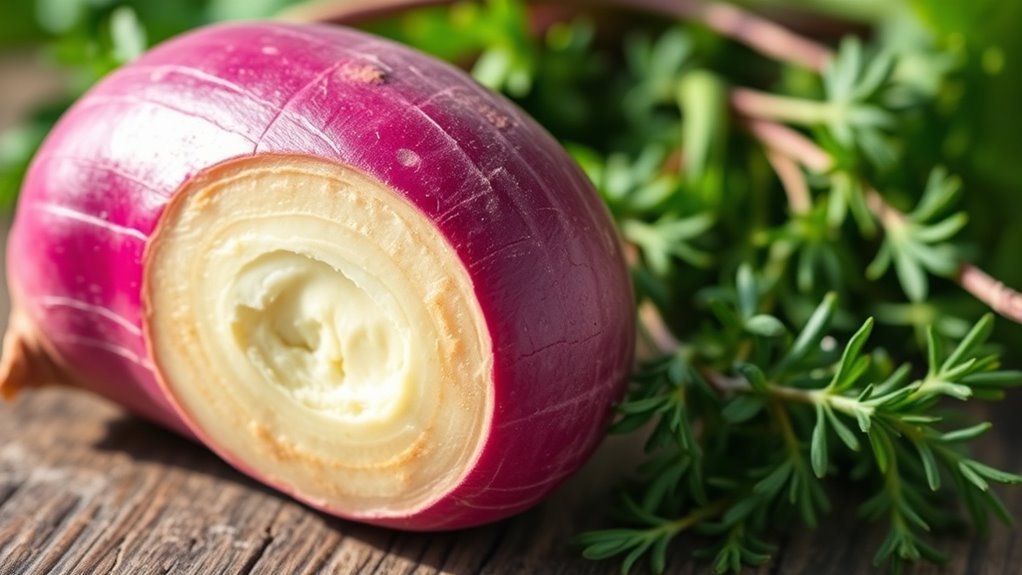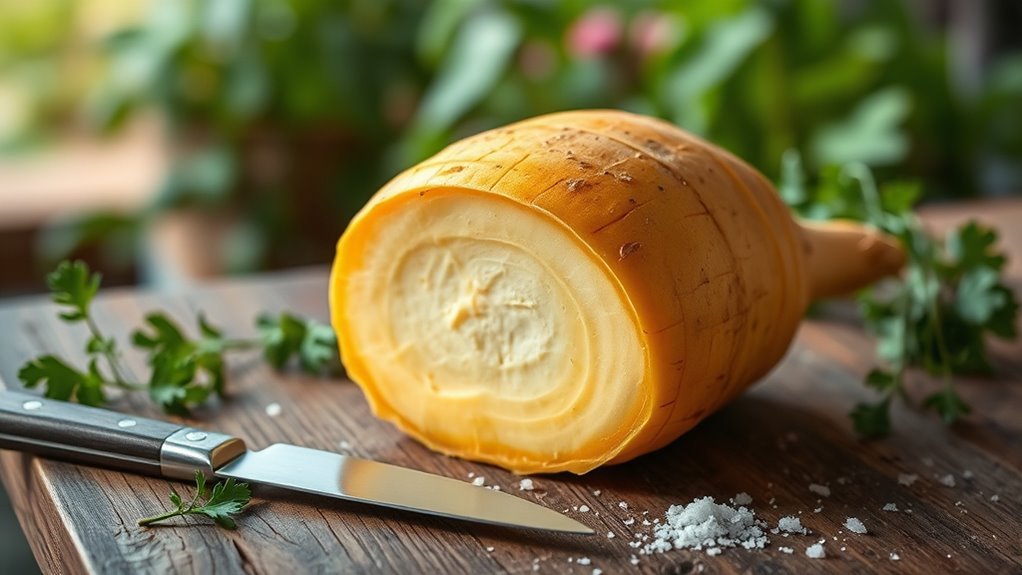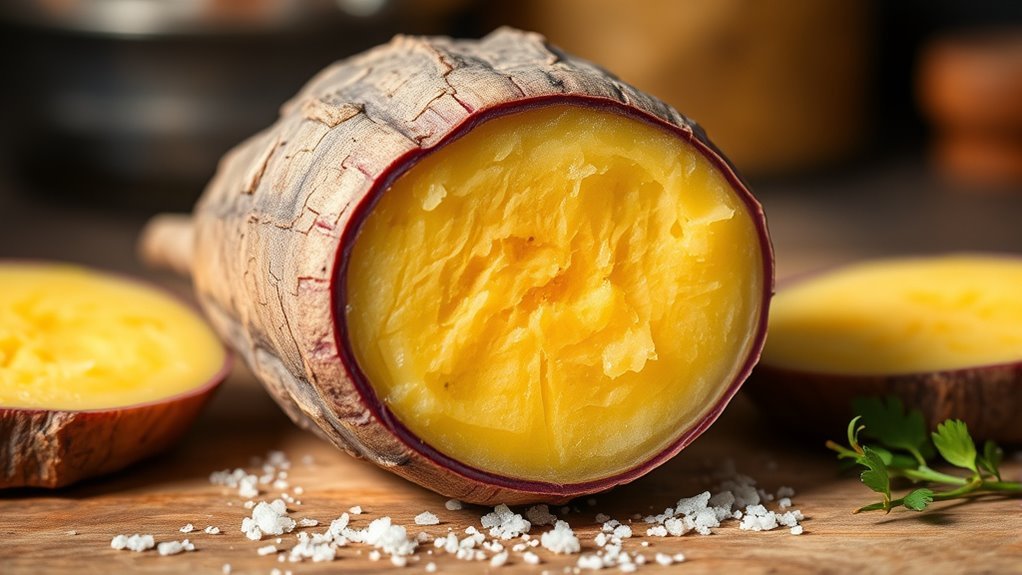Yes, rutabaga is considered keto-friendly. With about 8 grams of carbohydrates per serving and high fiber content, it can help maintain stable blood sugar levels. Rutabaga’s nutritional profile includes vitamins C and E, antioxidants, and dietary fiber, making it a healthy addition to your meals. You can enjoy it in various forms like fries or soups, which can add variety to your diet. There’s more to explore about integrating rutabaga into your ketogenic lifestyle.
Nutritional Profile of Rutabaga

When it comes to understanding the nutritional profile of rutabaga, you’ll find it’s a surprisingly versatile vegetable. Rutabagas come in various varieties, each offering a unique flavor and texture, but they generally share a rich nutrient profile. Packed with vitamins C and E, fiber, and antioxidants, they support your immune system and overall health. When it comes to storage, keep rutabagas in a cool, dark place, like a root cellar or the fridge, to maintain their freshness for weeks. You can also store them in a perforated plastic bag to extend their shelf life. Incorporating rutabaga into your meals can provide essential nutrients while adding variety to your diet, giving you the freedom to explore new culinary options.
Carbohydrate Content and Keto Considerations

When considering rutabaga on a keto diet, it’s important to look at its carbohydrate content and how it fits into your daily limits. With proper serving size, rutabaga can be a satisfying alternative to higher-carb vegetables, but it’s vital to compare it with other keto-friendly options. Understanding these factors can help you make informed choices that align with your dietary goals.
Rutabaga Nutritional Profile
Rutabaga, a root vegetable often overlooked, has garnered attention in the keto community due to its unique nutritional profile. With a history that dates back to ancient times, this versatile vegetable comes in several varieties, each offering distinct flavors and textures. A typical serving of rutabaga contains about 8 grams of carbohydrates, making it a lower-carb option compared to other starchy vegetables. While its carbohydrate content may still be higher than some keto-friendly foods, its fiber content can help mitigate blood sugar spikes. If you’re looking to diversify your vegetable intake while staying mindful of your carb limits, incorporating rutabaga might just be a flavorful solution. Just remember to balance it with other keto-friendly options for best results.
Keto-Friendly Alternatives
Although rutabaga can fit into a keto diet, you might be looking for alternatives that offer even lower carbohydrate content. Here are some keto-friendly options to evaluate:
| Alternative | Carbohydrate Content (per 100g) |
|---|---|
| Cauliflower | 3g |
| Zucchini | 3g |
| Radish | 1.8g |
Incorporating these options can help you stay within your carb limits while enjoying diverse flavors. Additionally, contemplate keto-friendly grains like almond flour or coconut flour for baking. For snacking, explore low carb snacks such as cheese crisps or nut-based treats. These alternatives not only keep your meals exciting but also empower your keto journey with the freedom to choose while maintaining ketosis!
Serving Size Considerations
While evaluating rutabaga for your keto diet, it’s important to take into account serving sizes, as they greatly influence carbohydrate intake. A typical serving size of rutabaga is around one cup, which contains approximately 8 grams of net carbs. For those adhering to a strict keto plan, this can be significant. Practicing portion control is essential; even small adjustments in serving size can help you stay within your carb limits. If you enjoy rutabaga, consider smaller portions or incorporating it into dishes with lower-carb ingredients. Balancing your love for rutabaga while maintaining your keto goals can provide flexibility, allowing you to enjoy your meals without feeling restricted. Just remember, moderation is key. Additionally, comparing rutabaga to higher carb content in beets can help you make informed choices about your vegetable intake on a keto diet.
Health Benefits of Rutabaga

One of the often-overlooked root vegetables, rutabaga boasts a variety of health benefits that can enhance your diet. Incorporating rutabaga into your meals not only adds flavor but also provides several health advantages:
- Rich in Nutrients: Rutabaga is packed with vitamins C and E, which support your immune system and skin health.
- High in Fiber: This root vegetable is a great source of dietary fiber, promoting digestive health and helping you feel full longer.
- Low in Calories: With its low-calorie content, rutabaga can be an excellent choice for weight management.
How to Prepare Rutabaga for a Ketogenic Diet
Incorporating rutabaga into a ketogenic diet can be both delicious and satisfying. When preparing rutabaga, start by peeling the tough skin, then chop it into cubes or slices, depending on your preferred cooking method. You can roast, steam, or sauté rutabaga to retain its nutrients while enhancing its flavor. Roasting brings out its natural sweetness, while steaming keeps it tender and low in calories. For a creamy texture, try mashing it with butter and seasonings. You might also incorporate rutabaga into soups or stews for a hearty, low-carb option. Remember, while rutabaga is lower in carbs than many other vegetables, moderation is key to staying within your daily carb limit on a ketogenic diet. Additionally, rutabaga is a good source of fiber which can support healthy digestion. Enjoy experimenting!
Rutabaga vs. Other Low-Carb Vegetables
Rutabaga stands out among low-carb vegetables for its unique flavor and nutritional profile. While other veggies like zucchini and cauliflower are popular in keto diets, rutabaga offers distinct advantages that you might appreciate:
- Rutabaga benefits: It’s a good source of vitamin C and fiber, aiding digestion and boosting your immune system.
- Flavor versatility: Its slightly sweet and earthy taste makes it a great substitute for higher-carb options like potatoes.
- Rutabaga storage: You can keep it in a cool, dark place for weeks, making it easy to incorporate into your meals without worrying about spoilage. Additionally, with approximately 8 grams of net carbs per 100 grams, it can fit into a low-carb diet in moderation.
Recipe Ideas Featuring Rutabaga
If you’re looking to incorporate rutabaga into your meals, there are plenty of delicious options to explore. You can try rutabaga mash as a creamy side, whip up some crispy rutabaga fries, or warm up with a savory rutabaga soup. Each of these recipes highlights rutabaga’s versatility and can fit seamlessly into a keto-friendly diet. Additionally, rutabagas contain 8 grams of net carbs per 100 grams, making them a suitable option for those monitoring their carb intake.
Rutabaga Mash Alternatives
While many people enjoy the creamy texture of traditional mashed potatoes, rutabaga offers a nutritious and low-carb alternative that can easily fit into a keto diet. You can experiment with various rutabaga variations to create delicious mash alternatives. Here are a few ideas to get you started:
- Garlic Rutabaga Mash: Add roasted garlic for an aromatic flavor boost.
- Creamy Rutabaga and Cauliflower: Mix mashed rutabaga with cauliflower for an even creamier texture, perfect for your keto plate.
- Herbed Rutabaga Mash: Use fresh herbs like thyme or rosemary combined with your favorite rutabaga seasoning to elevate the dish.
These options not only satisfy your cravings but also keep your carb count in check, allowing you to enjoy your meals without compromise!
Rutabaga Fries Recipe
When you’re looking for a tasty, low-carb snack, rutabaga fries can be a fantastic choice that fits seamlessly into a keto lifestyle. To make them, start by peeling and cutting your rutabaga into fry shapes. Toss them in a bowl with your favorite rutabaga seasoning—think garlic powder, paprika, and a pinch of salt. Next, use baking techniques like spreading them evenly on a parchment-lined baking sheet for ideal crispiness. Bake at 425°F (220°C) for about 25-30 minutes, flipping halfway through. The result? Crispy, flavorful fries that satisfy your cravings without derailing your diet. Enjoy them with a keto-friendly dipping sauce, and you’ve got yourself a delicious, guilt-free snack! Additionally, rutabagas are low in calories while being nutrient-dense, making them a great choice for maintaining a balanced diet.
Rutabaga Soup Variations
Rutabaga isn’t just great for fries; it also shines in soups, offering a rich, earthy flavor that can elevate your meals. You can easily whip up various rutabaga soup variations that cater to your taste and dietary needs. Here are a few ideas to get you started:
- Creamy Rutabaga Soup: Blend boiled rutabaga with cream and spices for a velvety texture.
- Spicy Rutabaga Soup: Add chili flakes or jalapeños to kick up the heat and awaken your taste buds.
- Rutabaga and Vegetable Medley: Combine rutabaga with seasonal veggies for a colorful, nutritious soup.
These variations not only make great use of rutabaga but also provide essential nutrients, ensuring you enjoy your meals while sticking to your keto lifestyle.
Tips for Incorporating Rutabaga Into Your Meal Plan
To successfully incorporate rutabaga into your meal plan, you’ll find it beneficial to experiment with its versatile nature in various dishes. Start by exploring rutabaga pairings; it complements flavors like garlic, rosemary, and cheese. You can mash it, roast it, or even use it in stir-fries. When it comes to rutabaga storage, keep it in a cool, dark place, ideally in a pantry or cellar to prolong freshness. After cutting, store it in the fridge in an airtight container. Consider adding rutabaga to soups or salads for a nutritious boost. By mixing it into your favorite recipes, you’ll not only enjoy its unique taste but also benefit from its low-carb, keto-friendly profile.
Frequently Asked Questions
Can I Eat Rutabaga on a Strict Keto Diet?
You can eat rutabaga on a strict keto diet, but moderation’s key. With its low carb count and high fiber, rutabaga nutrition can fit into your meal plan. It offers a great alternative to higher-carb veggies. Just remember, balancing your overall carb intake is essential. Explore keto alternatives like cauliflower or zucchini if you want more options. Embrace variety while still enjoying the flavors you love on your keto journey!
What Is the Glycemic Index of Rutabaga?
The glycemic index of rutabaga is around 62, which indicates a moderate glycemic impact. This means it can cause a moderate rise in blood sugar levels compared to lower-GI foods. Despite this, rutabaga offers numerous benefits, including being rich in vitamins and antioxidants. If you’re looking for a nutritious option, incorporating rutabaga in moderation might align with your dietary goals while still allowing for some freedom in your meal choices.
Is Rutabaga Suitable for Meal Prepping?
Yes, rutabaga is great for meal prepping! Its firm texture holds up well in the fridge, making it perfect for various rutabaga recipes. You can roast it, mash it, or add it to soups. The meal prep benefits include saving time and ensuring you have nutritious options ready to go. Plus, rutabaga’s low-calorie, high-fiber nature fits nicely into a balanced meal plan, giving you the freedom to enjoy flavorful dishes throughout the week.
How Does Rutabaga Affect Blood Sugar Levels?
Rutabaga can be a friend to your blood sugar levels, but it’s not a superhero. When you eat it, your body produces a moderate insulin response, helping to keep things balanced. It’s got a lower glycemic index compared to many starchy veggies, which means it won’t send your blood sugar soaring like a rocket. So, if you’re looking to maintain stable levels, rutabaga might just be a great addition to your meals!
Can Rutabaga Be Frozen for Later Use?
Yes, you can freeze rutabaga for later use. To guarantee quality, peel and cut it into cubes before blanching in boiling water for 2-3 minutes. After cooling it in ice water, drain and pack it in airtight containers or freezer bags. When stored properly, rutabaga can last for about 10-12 months in the freezer. Using these freezing techniques helps maintain its flavor and texture for when you need it later.


